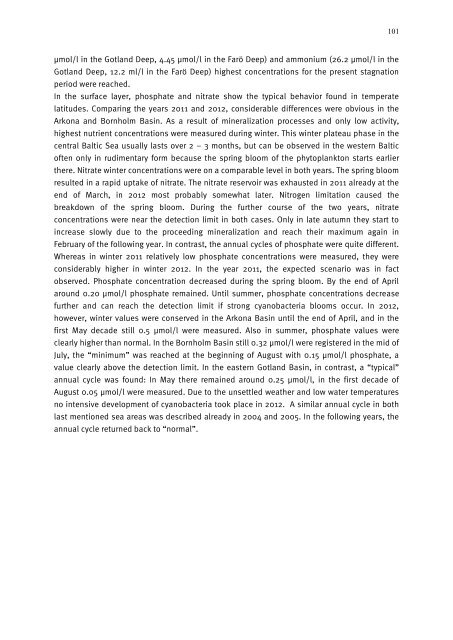Hydrographisch-hydrochemische Zustandseinschätzung der ... - IOW
Hydrographisch-hydrochemische Zustandseinschätzung der ... - IOW
Hydrographisch-hydrochemische Zustandseinschätzung der ... - IOW
Erfolgreiche ePaper selbst erstellen
Machen Sie aus Ihren PDF Publikationen ein blätterbares Flipbook mit unserer einzigartigen Google optimierten e-Paper Software.
101<br />
µmol/l in the Gotland Deep, 4.45 µmol/l in the Farö Deep) and ammonium (26.2 µmol/l in the<br />
Gotland Deep, 12.2 ml/l in the Farö Deep) highest concentrations for the present stagnation<br />
period were reached.<br />
In the surface layer, phosphate and nitrate show the typical behavior found in temperate<br />
latitudes. Comparing the years 2011 and 2012, consi<strong>der</strong>able differences were obvious in the<br />
Arkona and Bornholm Basin. As a result of mineralization processes and only low activity,<br />
highest nutrient concentrations were measured during winter. This winter plateau phase in the<br />
central Baltic Sea usually lasts over 2 – 3 months, but can be observed in the western Baltic<br />
often only in rudimentary form because the spring bloom of the phytoplankton starts earlier<br />
there. Nitrate winter concentrations were on a comparable level in both years. The spring bloom<br />
resulted in a rapid uptake of nitrate. The nitrate reservoir was exhausted in 2011 already at the<br />
end of March, in 2012 most probably somewhat later. Nitrogen limitation caused the<br />
breakdown of the spring bloom. During the further course of the two years, nitrate<br />
concentrations were near the detection limit in both cases. Only in late autumn they start to<br />
increase slowly due to the proceeding mineralization and reach their maximum again in<br />
February of the following year. In contrast, the annual cycles of phosphate were quite different.<br />
Whereas in winter 2011 relatively low phosphate concentrations were measured, they were<br />
consi<strong>der</strong>ably higher in winter 2012. In the year 2011, the expected scenario was in fact<br />
observed. Phosphate concentration decreased during the spring bloom. By the end of April<br />
around 0.20 µmol/l phosphate remained. Until summer, phosphate concentrations decrease<br />
further and can reach the detection limit if strong cyanobacteria blooms occur. In 2012,<br />
however, winter values were conserved in the Arkona Basin until the end of April, and in the<br />
first May decade still 0.5 µmol/l were measured. Also in summer, phosphate values were<br />
clearly higher than normal. In the Bornholm Basin still 0.32 µmol/l were registered in the mid of<br />
July, the ‛minimum“ was reached at the beginning of August with 0.15 µmol/l phosphate, a<br />
value clearly above the detection limit. In the eastern Gotland Basin, in contrast, a ‛typical“<br />
annual cycle was found: In May there remained around 0.25 µmol/l, in the first decade of<br />
August 0.05 µmol/l were measured. Due to the unsettled weather and low water temperatures<br />
no intensive development of cyanobacteria took place in 2012. A similar annual cycle in both<br />
last mentioned sea areas was described already in 2004 and 2005. In the following years, the<br />
annual cycle returned back to ‛normal“.

















